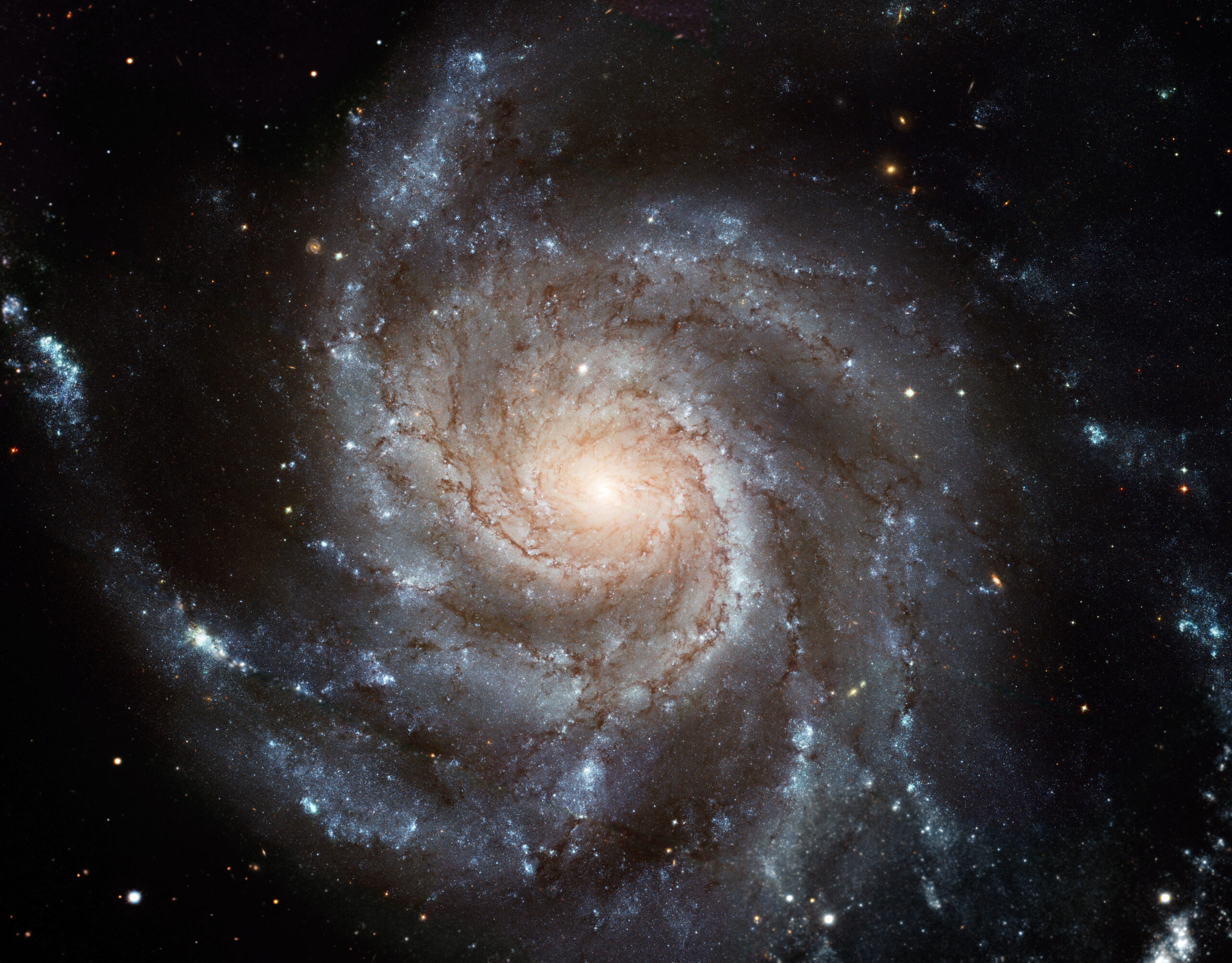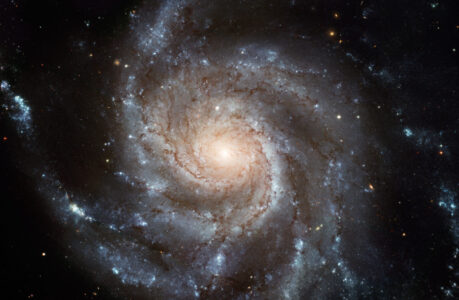Introduction
Messier 101, affectionately known as the Pinwheel Galaxy, has received a lot of attention recently with the discovery of Supernova SN 2023 ixf. But this isn’t the first time that the Pinwheel has spawned Supernova, so what is the Pinwheel galaxy and why is it the home for so many supernova?
Located in the constellation Ursa Major, this stunning spiral galaxy has captured the hearts and minds of astronomers and stargazers alike. With its intricate arms and vibrant core, Messier 101 is a celestial masterpiece that continues to inspire wonder and ignite our curiosity about the vastness of the universe. In this article, we will delve into the captivating features and fascinating history of Messier 101, exploring why it has become such a beloved object of astronomical study.
A Captivating Beauty
At first glance, Messier 101 stands out as a remarkable sight in the night sky. Spanning a diameter of approximately 170,000 light-years, this spiral galaxy boasts magnificent spiral arms that curl delicately outward from its bright, compact core. Its distinctive appearance resembles a grand pinwheel, hence its popular name.
The Pinwheel Galaxy’s spiral arms are adorned with countless clusters of bright, young stars, illuminating the surrounding cosmic dust and gas clouds. The interplay between light and shadow creates a mesmerizing tapestry of celestial artistry. The grandeur of Messier 101 is further enhanced by its numerous star-forming regions, where gas clouds collapse under their own gravity, giving birth to new generations of stars.
Location and Discovery
Messier 101 resides approximately 21 million light-years away from our own Milky Way galaxy. Its celestial coordinates place it in the constellation Ursa Major, the Great Bear, which is visible from the northern hemisphere throughout the year. This fortunate placement has made the Pinwheel Galaxy a popular target for both amateur and professional astronomers.
The discovery of Messier 101 is credited to the French astronomer Pierre Méchain, who first observed the galaxy on March 27, 1781. His colleague, Charles Messier, added it to his famous astronomical catalog just a few days later. Messier 101 was the 101st object listed in the catalog, hence its designation as Messier 101.
Characteristics and Structure
Messier 101 is classified as a spiral galaxy of the type Sc, falling into the category of “grand design” spirals. It is an example of a galaxy with well-defined spiral arms that extend all the way to its outer regions. The Pinwheel Galaxy’s spiral arms are thought to be the result of density waves propagating through its disk, compressing gas and triggering star formation along their path.
The core of Messier 101 is home to a supermassive black hole, which is common for many galaxies, including our own Milky Way. This black hole exerts a powerful gravitational force and plays a crucial role in shaping the galaxy’s structure and evolution. Surrounding the black hole is a bustling region filled with older stars, gas, and dust.
Stellar Populations
One of the most captivating aspects of Messier 101 is its rich and diverse stellar population. The galaxy’s spiral arms are studded with clusters of bright, young stars, formed relatively recently in cosmic timescales. These massive stars burn fiercely, emitting intense ultraviolet radiation that illuminates the surrounding interstellar medium.
In addition to the young, hot stars, Messier 101 also hosts a vast number of older, cooler stars. These stellar remnants have exhausted their nuclear fuel and have entered the final stages of their lives. Their cooler temperatures give them a reddish hue, providing a stark contrast to the younger, bluer stars in the galaxy. The interplay between these stellar populations creates a visually captivating mosaic of colors in Messier 101.
Supernovae and Starburst Activity
Messier 101 has been a hotbed of stellar explosions known as supernovae. These cataclysmic events occur when massive stars reach the end of their lives and undergo a violent collapse, releasing an enormous amount of energy in the process. These explosions can briefly outshine entire galaxies and leave behind a nebulous remnant.
Several supernovae have been recorded in Messier 101, with the most recent occurring in 2011. Designated as SN 2011fe, this supernova reached its peak brightness in August of that year, and its aftermath was extensively studied by astronomers. Such stellar explosions provide valuable insights into the life cycles of stars and the dynamics of galaxies.
The abundance of supernovae in Messier 101 is closely tied to its active star formation regions, known as starburst regions. These regions experience a rapid and intense burst of star formation, triggered by the compression of gas and the gravitational interactions within the galaxy. Messier 101’s vibrant starburst activity is a testament to the ongoing processes of stellar birth and death that shape the evolution of galaxies.
Observing Messier 101
Observing Messier 101 can be a rewarding experience for both amateur and professional astronomers. Its relative brightness and large angular size make it visible even with modest-sized telescopes. For optimal viewing, it is advisable to choose a location with minimal light pollution and a clear, dark sky.
When observing the Pinwheel Galaxy, it is the spiral arms that steal the show. The intricate structure and subtle variations in brightness along the arms are best appreciated under moderately high magnification. Take your time to observe the core, where the spiral arms originate, and trace the arms as they gracefully extend outward.
Photographing Messier 101 can yield stunning results, capturing the delicate details of its spiral arms and the interplay between star-forming regions and cosmic dust. Long-exposure photography, combined with appropriate filters, can reveal the intricate beauty hidden within this celestial masterpiece.
The Universe’s Endless Wonders
Messier 101, the Pinwheel Galaxy, stands as a testament to the universe’s boundless beauty and complexity. Its intricate spiral structure, vibrant stellar populations, and explosive starburst activity paint a vivid picture of the ongoing processes that shape galaxies. As we gaze at this distant celestial marvel, we are reminded of the vastness and grandeur of the cosmos, inviting us to explore further and unravel its secrets. Messier 101 beckons us to embark on an eternal journey of discovery, where the wonders of the universe know no bounds.
Supernovae in Messier 101
Messier 101, the Pinwheel Galaxy, has been a stage for several spectacular stellar explosions known as supernovae. These cataclysmic events mark the end of massive stars’ lives and release an immense amount of energy, outshining entire galaxies for brief periods. The occurrence of supernovae in Messier 101 provides astronomers with valuable opportunities to study the processes of stellar evolution and galaxy dynamics. Let’s explore some notable supernovae that have graced the stage of Messier 101.
SN 1909A
One of the earliest recorded supernovae in Messier 101 is known as SN 1909A. It was first discovered by astronomer Max Wolf on October 20, 1909. SN 1909A reached a peak brightness of approximately magnitude 14 and was classified as a Type I supernova, indicating that it lacked hydrogen lines in its spectrum. Although it was a relatively dim event, considering the vast distance to Messier 101, it marked the beginning of a long history of supernova observations in the galaxy.
SN 1951H
SN 1951H was a remarkable supernova that appeared in Messier 101 in 1951. Discovered by Milton L. Humason and Edwin Hubble, this Type I supernova reached an impressive peak brightness of magnitude 12.9, making it one of the brightest supernovae ever observed in the Pinwheel Galaxy. SN 1951H’s luminosity allowed astronomers to study its characteristics in great detail, providing valuable insights into the physics of supernova explosions.
SN 1970G
In 1970, Messier 101 hosted another memorable supernova, designated as SN 1970G. This Type II supernova was discovered by amateur astronomer Tom Reiland and reached a peak brightness of approximately magnitude 11.7. SN 1970G stood out as a significant event due to its relatively close proximity to the galaxy’s nucleus. The supernova’s proximity to the core made it an ideal target for detailed observational studies, shedding light on the mechanisms driving stellar explosions.
SN 2011fe
One of the most recent and noteworthy supernovae in Messier 101 is SN 2011fe. This Type Ia supernova was discovered on August 24, 2011, by a team of astronomers at the Palomar Transient Factory. SN 2011fe quickly became a focal point of scientific interest, as it was one of the closest and best-observed Type Ia supernovae in modern history. With a peak brightness of around magnitude 10.5, it was visible even with small telescopes.
SN 2011fe’s proximity to Earth allowed astronomers to study the details of its explosion and aftermath with unprecedented precision. Type Ia supernovae, like SN 2011fe, occur in binary star systems where one star is a white dwarf that accretes matter from its companion until it reaches a critical mass, triggering a runaway nuclear fusion reaction. The study of Type Ia supernovae plays a crucial role in measuring the expansion rate of the universe and our understanding of dark energy.
Contributions to Astrophysics
The occurrence of supernovae in Messier 101, such as SN 1951H and SN 2011fe, has contributed significantly to our understanding of various astrophysical phenomena. Supernovae provide astronomers with a unique opportunity to study the processes of stellar death, nucleosynthesis (the creation of elements heavier than helium), and the dispersal of enriched material into the interstellar medium.
Moreover, the luminosity of supernovae allows for accurate distance measurements to their host galaxies. By observing Type Ia supernovae, like SN 2011fe, astronomers have been able to refine their knowledge of cosmic distances and contribute to the discovery that the expansion of the universe is accelerating. This groundbreaking finding earned the 2011 Nobel Prize in Physics for the astronomers who made the observations.
Future Supernova Discoveries
Given the dynamic nature of galaxies and the ongoing processes of stellar evolution, it is highly likely that Messier 101 will continue to host supernovae in the future. With advancements in observational technology and the ever-watchful eyes of astronomers, the Pinwheel Galaxy will remain an exciting target for the discovery and study of these extraordinary cosmic events.
The occurrence of supernovae in Messier 101 serves as a reminder of the powerful forces at play in the universe. These stellar explosions, while marking the end of stars’ lives, also provide a starting point for new cosmic processes. As astronomers continue to monitor and study supernovae in Messier 101 and other galaxies, they unlock valuable insights into the life cycles of stars, the formation of elements, and the evolution of galaxies themselves.

